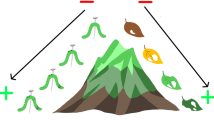Summary
Synchronous leaf production has been proposed as a mechanism to reduce herbivore damage to young leaves by satiating herbivores. To test this hypothesis, I measured leaf production, leaf survivorship, and herbivore damage on juveniles of Gustavia superba (H.B.K.) Berg (Lecythidaceae), in two sites in Central Panama. Leaves were produced throughout the year, but there were peaks in leaf production at the beginning of the wet scason. Plants that produced leaves synchronously with conspecifics received significantly less damage than plants that produced leaves out of synchrony, and high levels of leaf damage were correlated with shorter leaf lifetimes. These data suggest that plant phenology can influence risks of herbivory.
Similar content being viewed by others
References
Aide TM (1987) Limbfalls: a major cause of sapling mortality for tropical forest plants. Biotropica 19:284–285
Aide TM (1988) Herbivory as a selective agent on the timing of leaf production in a tropical understory community. Nature 336:574–575
Aide TM, Londoño EC (1989) The effects of rapid leaf expansion on the growth and survivorship of a lepidopteran herbivore. Oikos 55:66–70
Clark DB, Clark DA (1989) The role of physical damage in the seedling mortality regime of a neotropical rain forest. Oikos 55:225–230
Coley PD (1983) Herbivory and defensive characteristics of tree species in a lowland tropical forest. Ecol Monogr 53:209–233
Coley PD, Aide TM (1991) Comparison of herbivory and plant defenses in temperate and tropical broad-leafed forests. In: Price PW, Lewinsohn TM, Fernandes GW, Benson WW, (eds) Plant-animal interactions: evolutionary ecology in tropical and temperate regions. John Wiley and Sons, Inc., New York, pp 25–49
Collinge SK, Louda SM (1989) Influence of plant phenology on the insect herbivore/bittercress interaction. Oecologia 79:111–116
Crawley MJ (1986) Life history and environment. In Crawley MJ (ed) Plant ecology. Blackwell, Oxford, pp 253–290
Croat TB (1978) Flora of Barro Colorado Island. Stanford University Press, Stanford
Feeny P (1976) Plant apparency and chemical defense. In: Wallace J, Mansell RL (eds) Biochemical interaction between plants and insects. Recent Advances in Phytochemistry (Volume 10) Plenum Press, New York, pp 1–40
Foster RB, Brokaw NVL (1982) Structure and history of the vegetation of Barro Colorado Island. In: Leigh EG Jr, Rand AS, Windsor DM (eds) The ecology of a tropical forest: seasonal rhythms and long-term changes. Smithsonian Institution Press, Washington D.C., pp 67–81
Gage DA, Strong DR (1981) The chemistry of Heliconia imbricata and H. latispatha and the slow growth of a hispine beetle herbivore. Biochem Syst Ecol 9:79–82
Gartner BL (1989) Breakage and regrowth of Piper species in rain forest understory. Biotropica 21:303–307
Leigh EG Jr, Smythe N (1978) Leaf production, leaf consumption, and the regulation of folivory on Barro Colorado Island. In: Montgomery GG, (ed) The ecology of arboreal folivores. Smith-sonian Institution Press, Washington D.C., pp 33–50
Lieberman D, Lieberman M (1984) The causes and consequences of synchronous flushing in a dry tropical forest. Biotropica 16:193–201
Louda S (1984) Herbivory effects on stature, fruiting, and leaf dynamics of a native crucifer. Ecology 65:1379–1386
Macauley BJ, Fox LR (1980) Variation in total phenols and condensed tannins in Eucalyptus: Leaf phenology and insect grazing. Aust J Ecol 5:31–35
McKey D (1989) Interactions between ants and leguminous plants. In: Stirton CH, Zarucchi JL (eds) Advances in legume biology. (Missouri Botanical Garden Number 29), St Louis
Mori SA, Kallunki JA (1976) Phenology and floral biology of Gustavia superba (Lecythidaceae) in Central Panama. Biotropica 8:184–192
Nilsen ET, Sharifi MR, Virginia RA, Rundel PW (1987) Phenology of warm desert phreatophytes: seasonal growth and herbivory in Prosopis glandulosa var. torreyana (honey mesquite). J Arid Envir 13:217–229
Schupp EW, Feener DHJr (1990) Phylogeny, lifeform, and habitat dependence of ant-defended plants in a Panamanian forest. In: Huxley C, Cutler DK (eds) Ant-plant interactions. Oxford University Press, Oxford, pp 175–197
Shepherd JD (1985) Adjusting foraging effort to resources in adjacent colonies of the leaf-cutter ant Atta colombica Biotropica 17:245–252
Sork VL (1987) Effects of predation and light on seedling establishment in Gustavia superba. Ecology 68:1341–1350
Windsor D (1990) Climate and moisture variability in a tropical forest:long-term records from Barro Colorado Island, Panamá. Smithsonian Institution Press, Washington D.C.
Author information
Authors and Affiliations
Rights and permissions
About this article
Cite this article
Aide, T.M. Synchronous leaf production and herbivory in juveniles of Gustavia superba . Oecologia 88, 511–514 (1991). https://doi.org/10.1007/BF00317713
Received:
Accepted:
Issue Date:
DOI: https://doi.org/10.1007/BF00317713




